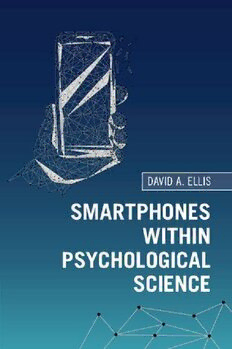Table Of ContentSMARTPHONES WITHIN PSYCHOLOGICAL
SCIENCE
Psychologists can now quantify behaviours beyond the laboratory
usingamass-adopted,unifiedsystemthatisprimedfordatacapture
a.k.a. smartphones. This is the first book to bring together related
areasofsmartphoneresearchandpointtowardshowpsychologycan
benefitandengagewiththesedevelopmentsinthefuture.Itcritically
considers how smartphones and related digital devices help answer
and generate new research questions for psychological science. The
book then guides readers through how smartphones are being used
within psychology and social science more broadly. Drawing from
examples of both good and bad practice within current research, a
new perspective is brought to major themes and debates across
behavioural science. In the digital age, smartphones and associated
devices will be able to accomplish much more in the near future.
Psychology has a key role to play when it comes to balancing this
monumentalpotentialwithcarefullyconsideredresearch.
DavidA.EllisisanAssociateProfessorofInformationSystemsatthe
UniversityofBathandholdsanHonoraryResearchFellowshipatthe
University of Lincoln. His research to date has been published in
psychological, medical, and computer science journals with results
regularlyappearingonTVandRadio.
SMARTPHONES WITHIN
PSYCHOLOGICAL SCIENCE
DAVID A. ELLIS
UniversityofBath
UniversityPrintingHouse,Cambridgecb28bs,UnitedKingdom
OneLibertyPlaza,20thFloor,NewYork,ny10006,USA
477WilliamstownRoad,PortMelbourne,vic3207,Australia
314–321,3rdFloor,Plot3,SplendorForum,JasolaDistrictCentre,
NewDelhi–110025,India
79AnsonRoad,#06–04/06,Singapore079906
CambridgeUniversityPressispartoftheUniversityofCambridge.
ItfurtherstheUniversity’smissionbydisseminatingknowledgeinthepursuitof
education,learning,andresearchatthehighestinternationallevelsofexcellence.
www.cambridge.org
Informationonthistitle:www.cambridge.org/9781108497954
doi:10.1017/9781108671408
©CambridgeUniversityPress2020
Thispublicationisincopyright.Subjecttostatutoryexception
andtotheprovisionsofrelevantcollectivelicensingagreements,
noreproductionofanypartmaytakeplacewithoutthewritten
permissionofCambridgeUniversityPress.
Firstpublished2020
AcataloguerecordforthispublicationisavailablefromtheBritishLibrary.
LibraryofCongressCataloging-in-PublicationData
names:Ellis,DavidA,1986–author.
title:Smartphoneswithinpsychologicalscience/DavidAEllis.
description:NewYork:CambridgeUniversityPress,2020.|Includesindex.
identifiers:lccn2020018183(print)|lccn2020018184(ebook)|isbn9781108497954
(hardback)|isbn9781108671408(ebook)
subjects:lcsh:Technologicalinnovations–Psychologicalaspects.|Smartphones.|
Human-computerinteraction.|Emotionalintelligence.
classification:lccqa76.9.p75e452020(print)|lccqa76.9.p75(ebook)|
ddc004.16701/9–dc23
LCrecordavailableathttps://lccn.loc.gov/2020018183
LCebookrecordavailableathttps://lccn.loc.gov/2020018184
isbn978-1-108-49795-4Hardback
isbn978-1-108-70934-7Paperback
CambridgeUniversityPresshasnoresponsibilityforthepersistenceoraccuracyof
URLsforexternalorthird-partyinternetwebsitesreferredtointhispublication
anddoesnotguaranteethatanycontentonsuchwebsitesis,orwillremain,
accurateorappropriate.
To Mum, Dad and Brittany
Contents
ListofFigures pagex
ListofTables xii
Preface xiii
Acknowledgements xvi
Introduction 1
AnaloguetoDigital 2
LimitationsoftheLaboratory 5
BeyondtheLaboratory 7
DirectObservation 7
MassCommunication(Pre-Smartphone) 8
SensorTechnology 11
ComputationalSocialScience 15
Smartphones:PromisesandBarriersforPsychologicalScience 17
GeneralOverview 20
1 SmartphoneUsage 27
1.1 TheDarkSide 29
1.2 CapturingUsagefromSelf-Report 30
1.3 ObjectiveMeasuresofSmartphoneUsage 34
1.4 ConceptualandMethodologicalChallenges 38
1.4.1 Conceptual 38
1.4.2 Methodological 39
1.5 Conclusion 41
2 HealthandBehaviourChange 44
2.1 AmbulatoryAssessment:DigitisedSelf-Report 46
2.1.1 ActiveMonitoring 48
2.1.2 PassiveMonitoring 50
2.2 PhysicalActivityInterventions 53
2.2.1 TheImportanceofFailure 56
2.2.2 FutureResearch 59
2.3 AutomatedTrackingofEmotionandMood 60
2.3.1 Well-beingInterventionsandPsychologicalHarm 62
vii
viii Contents
2.4 IndividualisedInterventions:TheFutureofRCTs 65
2.5 CareDelivery:ACompleteSystemsApproach 68
2.6 Conclusion 70
3 SocialInteractionandInterpersonalRelationships 73
3.1 DoSmartphonesImpedeSocialInteraction? 74
3.1.1 LimitationsandFutureResearch 76
3.2 Long-TermRelationships:SameButDifferent 80
3.2.1 Same 80
3.2.2 Different 82
3.3 AutomaticTrackingofSocialBehaviour 84
3.3.1 DigitalDatingMetrics 85
3.3.2 SensingSocialBehaviours 87
3.4 ShapeShiftingbetweenContexts 90
3.5 Conclusion 93
4 PersonalityandIndividualDifferences 96
4.1 PersonalMicrobe:BiologicalTraces 97
4.2 TheExtendedSelf:PsychologicalTraces 98
4.3 Personality 102
4.3.1 ABriefHistory 102
4.3.2 PersonalityMeasurementandPrediction 104
4.3.3 PersonalityExplanationandDevelopment 106
4.3.4 CanSmartphonesRevolutionisePsychometricAssessment? 110
4.5 Conclusion 112
5 Cognition 115
5.1 CognitiveDevelopment 116
5.2 AdultCognition 117
5.2.1 Attention 117
5.2.2 Memory 120
5.2.3 DelayDiscounting 123
5.2.4 CollectiveandHigher-OrderEffectsonCognition 124
5.3 LimitationsandFutureResearch 126
5.3.1 CognitiveBiases:TheKidsAreAllRight 128
5.4 SmartphonesasaPlatformforCognitiveScience 129
5.4.1 LimitationsandFutureResearch 134
5.5 Conclusion 135
6 SafetyandSecurity 138
6.1 SafetyandDigitalHarm 139
6.2 SecurityPerceptions 142
6.3 SmartphoneSecurityThreats 145
6.4 ImprovingSecurity 148
6.4.1 PlayingtoPsychologicalStrengths 149
Contents ix
6.4.2 CommercialSoftwareDevelopment 153
6.4.3 EthicalPracticesforPsychologicalResearch 155
6.5 Conclusion 160
Conclusion 163
FutureSmartphoneResearch 164
MethodologicalDevelopment:Software 164
MethodologicalDevelopment:Hardware 169
TheoryandMeasurement 171
TechnologicalDéjàVu 178
InterdisciplinaryResearch,SpeedandProductivity 180
Communication 183
FinalThoughts 185
References 187
Index 253
Figures
I.1 Examplesofwearablesensorsthatcanmeasure page14
avarietyofbehavioursandphysiologicalresponsesthat
areofparticularinterestforbothmedicineandpsychological
science
I.2 Examplesofsensorsandtrackingfeaturescommonlyfound 18
inmodernsmartphones
1.1 Barcodegraphicthatplotssmartphoneusesoveratwo-week 28
period
1.2 Publicationofself-reportinstrumentsbetween2004and2018 30
(extractedfromTable1.1),whichaimtoassessavarietyof
constructsassociatedwithsmartphoneuseinthegeneral
population
1.3 DatafromEllisetal.(2019)illustratingweakassociations 36
betweenobjectivedata–inthiscasesmartphonepickups
andsmartphoneusagescales
2.1 Examplesofdigitaltracesthatcanbeharvested 45
fromsmartphonesandrelatedwearabledevices
2.2 Asimplevisualisationderivedfromashortperiod 51
oflocationtracking(Geyeretal.,2019)
2.3 Guidelinesthatweredevelopedfollowingareviewofpapers 57
thatdocumentfailuresinwearableinterventionswhich
aimtoencouragephysicalactivity
3.1 Interactantjudgmentaccuracyasafunctionofinteraction 79
contextandpersonalitytraitfollowingashortsocial
interaction(Walletal.,2013)
5.1 Agamifiedversionofthestop-signalreactiontimetask 132
(Brownetal.,2014)
6.1 Examplesofindividualimagesandanaverageontheright, 150
whichcanbegeneratedfrommultiplephotosofthesame
individual
x

